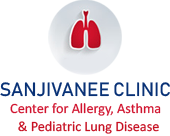Manage Asthma In School
What Is Asthma?
Asthma is a chronic lung disease that affects the airways. Children with asthma have airways that are inflamed. Inflamed airways are very sensitive, so they tend to react strongly to things called “triggers.” When the airways react to a trigger, they become narrower due to swelling and squeezing of the airways by the small muscles around them. This results in less air getting through to the lungs and less air getting out. Symptoms of asthma include acute episodes of:
- Coughing
- Wheezing (a whistling or squeaky sound during breathing)
- Chest tightness
- Shortness of breath
Symptoms can vary in severity; they can be mild or moderate and affect activity levels, or they can be severe and life threatening. Asthma triggers and symptoms vary from one person to another. Some children have asthma symptoms only occasionally, while others have symptoms almost all the time.
Common Asthma Triggers
Although triggers that cause an asthma episode vary among individuals, there are several common triggers.
- Allergens such as pollen, animal dander, dust mites, cockroaches, and molds
- Irritants such as cold air, perfume, pesticides, strong odors, weather changes, cigarette smoke, and chalk dust
- Respiratory infections such as a cold or the flu • Physical exercise, especially in cold weather
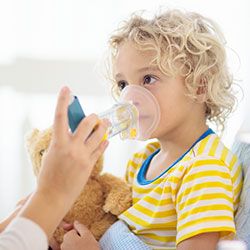
Why Be Concerned About Asthma At School?
Almost 3 students in a class- room of 30 currently have asthma. Uncontrolled asthma can result in reduced performance for the child with asthma and disruptions for the entire classroom.
Students with asthma can function to their maximum potential if their needs are met. The benefits to students include better attendance; improved alertness and physical stamina; fewer symptoms; and fewer restrictions on participation in physical activities and special events, such as field trips, and fewer medical emergencies. Schools and their staff can work together with parents or guardians, students, and health care providers to minimize risk and to provide a healthy and safe educational environment for students with asthma.
Asthma Is A Leading Cause Of School Absenteeism.
Asthma is one of the leading causes of school absence due to illness. Approximately 9.2 million children younger than 18 years of age have been diagnosed with asthma in their lifetime; 3.2 million or approximately 6 percent of children ages 5 to 17 had an asthma episode (attack) in the preceding year (2001 NHIS data).School staff members can play an important role in helping students with asthma manage their disease at school.
Actions For The Classroom Teacher Help Children With Asthma And Their Families Manage Asthma
- Consult with your school nurse or principal for updated policy and procedures for managing students with chronic health conditions, such as asthma, including managing medication and responding to emergencies, such as an asthma episode (attack).
- Know your role. Ask the student to tell you when he/she is experiencing any difficulty in breathing, and know what steps to take in case of an asthma episode. Don’t delay getting medical help for a student with severe or persistent breathing difficulty.
- Develop a clear procedure with the student and his or her parent(s) or guardian(s) for handling schoolwork missed if the student has episodes of illness or misses school.
- Report if a student’s symptoms are interfering with learning or activities with peers. Possible side effects of medicine that warrant referral are nervousness, nausea, jitteriness, hyperactivity, and drowsiness.
- Alert school administrators, school nurses, and parent(s) or guardian(s) of changes in a student’s performance or behavior that might reflect trouble with asthma. The vast majority of students with asthma are able to participate fully in the school program when their asthma is well managed.
- Encourage the student with asthma to participate fully in physical activities. Plan activities to allow for variations in stamina or tolerance for exercise, especially if the student is recovering from illness. Changes in weather conditions (hot, cold, breezy) and poor air quality (smoke, smog, pollen) often can aggravate asthma.
Look For Children With Uncontrolled Asthma
Be alert for signs of uncontrolled asthma.
- Lingering cough after a cold
- Persistent cough during the day
- Coughing during the night or early in the morning
- Coughing, wheezing, chest tightness, or shortness of breath after vigorous physical activity or activity in cold or windy weather
- Low level of stamina during physical activity or reluctance to participate
- Coughing, wheezing, chest tightness, or shortness of breath even though the child is taking medicine for asthma
- Increased use of asthma medicine to relieve coughing, wheezing, chest tightness, or shortness of breath
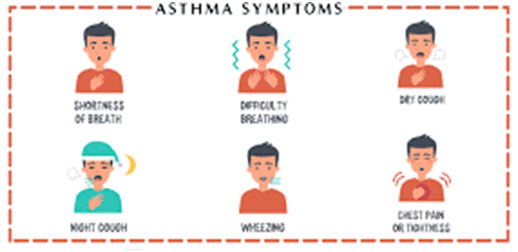
Early Signs Of An Asthma Episode
In asthma education programs, students are taught to identify early warning signs— the physical changes that occur in the early stage of airway obstruction. These early warning signs usually happen before more serious symptoms occur. They alert students that it is time to measure their peak flow and take medication according to their action plan. Each student’s early warning signs should be documented in the student’s asthma action plan available in the school health room or clinic. Teachers should be aware of each student’s early signs and symptoms and enable students with asthma to take the proper steps to prevent more serious asthma trouble.
Recognizing the early warning signs of an asthma episode can avoid a more serious medical emergency. There should be no delay once a student has notified the teacher of a possible problem. A student may have one or more of these symptoms during the initial phase of an asthma episode.
1.Changes in breathing
Early signs may include:
- Coughing
- Chest tightness
- Throat tightness
- Breathing through the mouth Later signs may include
- Wheezing
- Shortness of breath
- Rapid breathing
2. Verbal Complaints
Often a student who is familiar with asthma will know that an episode is about to happen. The student might tell the teacher:
- “My chest is tight.”
- “My chest hurts.”
- “I cannot catch my breath.”
- “My mouth is dry.”
- “My neck feels funny.”
- “I don’t feel well” or “I feel tired.”
Use Of A Metered Dose

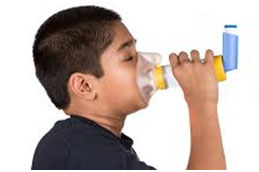
A metered dose inhaler (MDI) is a device used to deliver asthma medication directly to the lungs. In order to ensure effective administrationof the medicine, the following steps should be performed:
- Remove cap and hold inhaler upright.
- Shake inhaler.
- Tilt head back slightly and breathe out.
- Position inhaler in one of the following ways:
- Open mouth and hold inhaler 1–2 inches away.
- Use spacer (recommended for children for any inhaled asthma medication and for adults/children using inhaled steroids).
- Put inhaler in mouth.
- Press down on inhaler to release medication as you start to breathe in slowly.
- Breathe in slowly (3–5 seconds).
- Hold breath for 10 seconds to allow medicine to reach deeply into the lungs.
- Repeat puffs as directed. Waiting 1 minute between puffs may permit the second puff to penetrate the lungs better.
A peak flow meter is a useful tool for objectively measuring the severity of asthma. The number obtained is called a peak expiratory flow rate (PEFR). The PEFR indicates the degree of obstruction or narrowing of the airways.
The PEFR is the amount of air that can be forcefully exhaled. Each individual has a predicted rate based on height and age. However, many physicians prefer to use the person’s “personal best” value. This number represents the highest rate obtained when a person is feeling well.
- Place indicator at the base of the numbered scale.
- Stand up.
- Take a deep breath.
- Place the meter in the mouth and close lips around the mouthpiece.
- Blow out as hard and fast as possible.
- Write down the achieved value.
- Repeat the process two more times.
- Record the highest of the three numbers achieved.
This procedure can help determine when medicine or a change in treatment is necessary.
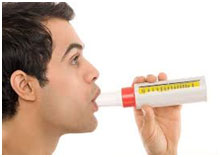
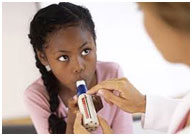
Notice any signs of Lungs related issue in your child ?
